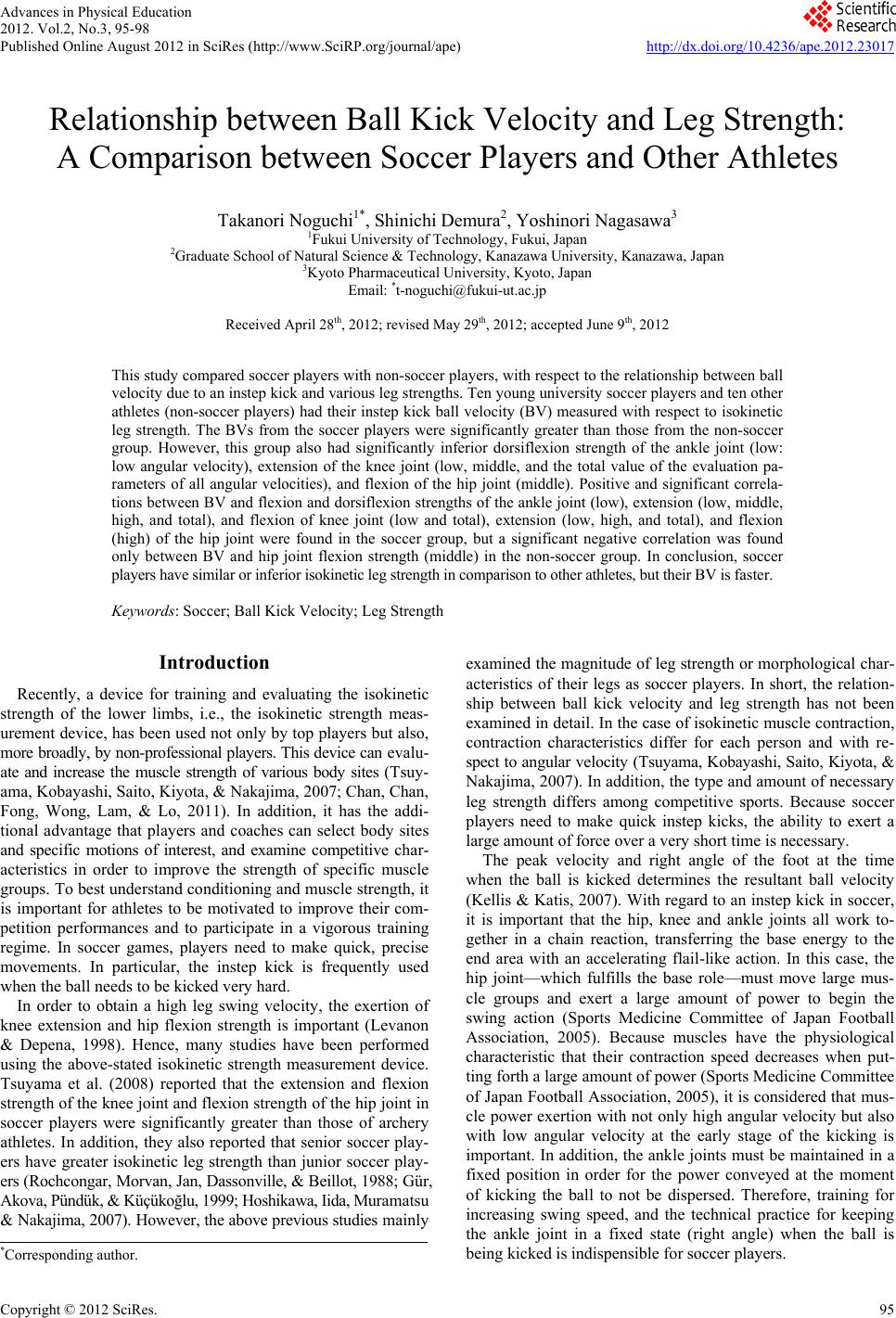
Advances in Physical Education
2012. Vol.2, No.3, 95-98
Published Online August 2012 in SciRes (http://www.SciRP.org/journal/ape) http://dx.doi.org/10.4236/ape.2012.23017
Copyright © 2012 SciRes. 95
Relationship between Ball Kick Velocity and Leg Strength:
A Comparison between Soccer Players and Other Athletes
Takanori Noguchi1*, Shinichi Demura2, Yoshinori Nagasawa3
1Fukui University of Technology, Fukui, Japan
2Graduate School of Natural Science & Technology, Kanazawa University, Kanazawa, Japan
3Kyoto Pharmaceutical University, Kyoto, Japan
Email: *t-noguchi@fukui-ut.ac.jp
Received April 28th, 2012; revised May 29th, 2012; accepted June 9th, 2012
This study compared soccer players with non-soccer players, with respect to the relationship between ball
velocity due to an instep kick and various leg strengths. Ten young university soccer players and ten other
athletes (non-soccer players) had their instep kick ball velocity (BV) measured with respect to isokinetic
leg strength. The BVs from the soccer players were significantly greater than those from the non-soccer
group. However, this group also had significantly inferior dorsiflexion strength of the ankle joint (low:
low angular velocity), extension of the knee joint (low, middle, and the total value of the evaluation pa-
rameters of all angular velocities), and flexion of the hip joint (middle). Positive and significant correla-
tions between BV and flexion and dorsiflexion strengths of the ankle joint (low), extension (low, middle,
high, and total), and flexion of knee joint (low and total), extension (low, high, and total), and flexion
(high) of the hip joint were found in the soccer group, but a significant negative correlation was found
only between BV and hip joint flexion strength (middle) in the non-soccer group. In conclusion, soccer
players have similar or inferior isokinetic leg strength in comparison to other athletes, but their BV is faster.
Keywords: Soccer; Ball Kick Velocity; Leg Strength
Introduction
Recently, a device for training and evaluating the isokinetic
strength of the lower limbs, i.e., the isokinetic strength meas-
urement device, has been used not only by top players but also,
more broadly, by non-professional players. This device can evalu-
ate and increase the muscle strength of various body sites (Tsuy-
ama, Kobayashi, Saito, Kiyota, & Nakajima, 2007; Chan, Chan,
Fong, Wong, Lam, & Lo, 2011). In addition, it has the addi-
tional advantage that players and coaches can select body sites
and specific motions of interest, and examine competitive char-
acteristics in order to improve the strength of specific muscle
groups. To best understand conditioning and muscle strength, it
is important for athletes to be motivated to improve their com-
petition performances and to participate in a vigorous training
regime. In soccer games, players need to make quick, precise
movements. In particular, the instep kick is frequently used
when the ball needs to be kicked very hard.
In order to obtain a high leg swing velocity, the exertion of
knee extension and hip flexion strength is important (Levanon
& Depena, 1998). Hence, many studies have been performed
using the above-stated isokinetic strength measurement device.
Tsuyama et al. (2008) reported that the extension and flexion
strength of the knee joint and flexion strength of the hip joint in
soccer players were significantly greater than those of archery
athletes. In addition, they also reported that senior soccer play-
ers have greater isokinetic leg strength than junior soccer play-
ers (Rochcongar, Morvan, Jan, Dassonville, & Beillot, 1988; Gür,
Akova, Pündük, & Küçükoğlu, 1999; Hoshikawa, Iida, Muramatsu
& Nakajima, 2007). However, the above previous studies mainly
examined the magnitude of leg strength or morphological char-
acteristics of their legs as soccer players. In short, the relation-
ship between ball kick velocity and leg strength has not been
examined in detail. In the case of isokinetic muscle contraction,
contraction characteristics differ for each person and with re-
spect to angular velocity (Tsuyama, Kobayashi, Saito, Kiyota, &
Nakajima, 2007). In addition, the type and amount of necessary
leg strength differs among competitive sports. Because soccer
players need to make quick instep kicks, the ability to exert a
large amount of force over a very short time is necessary.
The peak velocity and right angle of the foot at the time
when the ball is kicked determines the resultant ball velocity
(Kellis & Katis, 2007). With regard to an instep kick in soccer,
it is important that the hip, knee and ankle joints all work to-
gether in a chain reaction, transferring the base energy to the
end area with an accelerating flail-like action. In this case, the
hip joint—which fulfills the base role—must move large mus-
cle groups and exert a large amount of power to begin the
swing action (Sports Medicine Committee of Japan Football
Association, 2005). Because muscles have the physiological
characteristic that their contraction speed decreases when put-
ting forth a large amount of power (Sports Medicine Committee
of Japan Football Association, 2005), it is considered that mus-
cle power exertion with not only high angular velocity but also
with low angular velocity at the early stage of the kicking is
important. In addition, the ankle joints must be maintained in a
fixed position in order for the power conveyed at the moment
of kicking the ball to not be dispersed. Therefore, training for
increasing swing speed, and the technical practice for keeping
the ankle joint in a fixed state (right angle) when the ball is
being kicked is indispensible for soccer players.
*Corresponding author.